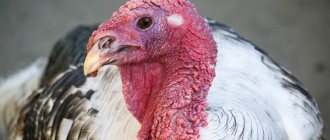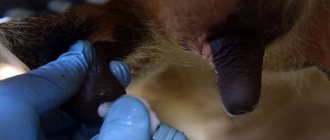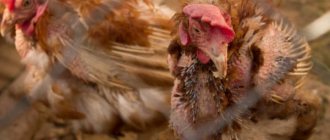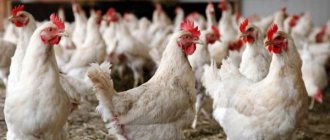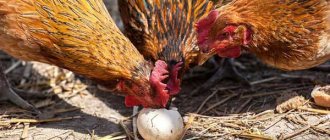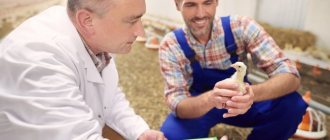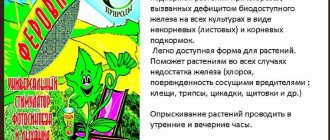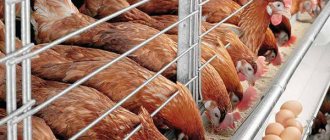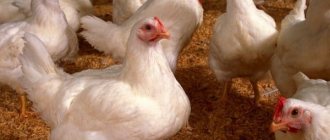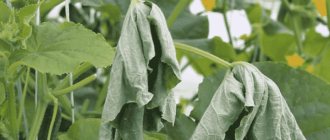What is diarrhea: signs of diarrhea
Diarrhea is not an independent disease, but a clinical syndrome associated with several diseases. Regardless of the cause, during diarrhea, the body's absorption of fluid from the intestines is altered, resulting in a life-threatening electrolyte imbalance. That is, the calf loses fluid, quickly becomes dehydrated, and suffers from electrolyte loss and acidosis. Infectious agents can cause problems in the intestines, but actual death from diarrhea in cattle usually results from dehydration, acidosis, and electrolyte loss.
Diarrhea can be mild, manifested by loose stools, moderate when dehydration is already severe, but the animal can stand on its feet, and severe when the calf stops eating and lies down all the time. In addition, the infection may differ in the color of the stool: it can be green, mucous, lumpy and mixed with blood, which is especially dangerous.
Causes of diarrhea
Animal owners are wondering why the calf has diarrhea if it has not eaten anything but milk. In fact, food has nothing to do with it in most cases. This problem is viral in nature, so the baby could simply become infected. For example, a common cause of diarrhea is rotavirus infection; its share accounts for more than 30% of all cases of diarrhea in a herd. This virus is present on every farm, so almost all calves are at risk. Other agents, in particular E. coli, coronavirus and Cryptosporidia, can also cause this unpleasant condition. They are dangerous individually; in addition, they are easily combined with rotavirus infection, causing an acute form of diarrhea, which complicates treatment. Identification of infectious disease agents that cause diarrhea is important for implementing effective preventive and treatment measures.
signs of diarrhea in calves
Causes of diarrhea are grouped into two categories: 1) non-infectious causes and 2) infectious causes.
- Non-infectious causes . They are often called predisposing factors - these are a number of factors that must be eliminated first. Any attempt to prevent infectious causes is usually futile unless control of non-infectious factors is part of the overall program. The group of non-infectious causes includes: inadequate nutrition of the cow during pregnancy, difficult living conditions, insufficient attention to the newborn calf, dirt. A lack of vitamins A, E and microelements will also lead to diarrhea. Increased humidity and hypothermia (hypothermia) lead to a decrease in colostrum consumption and weakening of the animal's body.
- Infectious causes . They can be grouped as follows: bacteria (E. coli, salmonella, Clostridium Perfringens, etc.), viruses (coronavirus, rotavirus, BVD virus, IBR virus), protozoa (Cryptosporidium, coccidia), yeast and mold.
Prevention as a method of prevention
Treatment of diarrhea is a difficult and painstaking process, which sometimes even an adult cow cannot endure. In order to prevent the occurrence of the disease, you need to take time to prevent it. Sometimes prevention is considered a much more effective and relatively cheaper option compared to other remedies (even folk remedies).
The following preventive measures can prevent the disease from appearing:
- Often the causes of many diseases lie in improper sanitary and hygienic care. This also applies to young cows: it is necessary to ensure the cleanliness and safety of the premises, as well as protecting individuals from extreme heat and frost.
- There will be no need to treat livestock if the cow is vaccinated in a timely manner: the vaccine will give the baby a greater chance of survival and living in critical environmental conditions.
- The quality of colostrum should also be at its best - it is important to try to control its abundance and quality together with your doctor.
- The calf and cow should be protected from contact with the manure of other livestock and animals, because this is a real source of viruses and bacteria. If possible, temporary isolation from other livestock should be established.
- Poor quality food can easily cause distress, so it is necessary to ensure that the food includes all the necessary vitamins and minerals.
- It is impossible to cure diarrhea without following a strict diet and drinking regimen.
Failure to follow at least one of the tips can lead to diarrhea, and consequently to increased mortality of calves.
Now you know the dangers of diarrhea in newborn calves, which must be treated carefully and quickly. It also became clear whether it is possible to give antibiotics to calves against diarrhea. In order to detect the approach of a disease, it is extremely important to pay attention to the animal: does it constantly drink water instead of milk, does it grind its teeth, or vomit blood. It is extremely important not to forget that an animal, and even more so a newborn organism, needs extremely healthy and proper food and proper care. The causes of the disease are sometimes so unexpected that they take the farmer by surprise.
Bacterial causes of diarrhea in calves
- We should also talk about Escherichia coli (E.coli). There are numerous serotypes (species) of this bacterium, and most strains that cause diarrhea first colonize in the calf's intestine. They do this with the help of very thin fimbriae. Fambria (pili) may contain the K99 antigen, in which case they are called enterotoxigenic (ETEC). Enterotoxigenic means that these bacteria have the ability to produce toxins in the intestines. E.coli enter the body of cattle from the environment. This happens especially often in dirty rooms where manure is poorly removed. The smaller the sick calf, the greater the chance of death from progressive dehydration.
- Another parasite is Salmonella Salmonella secretes a powerful toxin (endotoxin, poison). This infection can only be cured with antibiotics. In other cases, endotoxin will poison the animal, causing endotoxin shock. This pathology is detected in calves at six days and older. The source of salmonella infection in a herd can be other cattle, birds, cats, rodents, dirty water and even humans. Clinical signs associated with Salmonella infection include diarrhea, blood and fibrin in the stool, depression and fever. The disease is more severe in young and weakened calves.
- Clostridium perfringens. This infection is commonly known as enterotoxemia. Enterotoxemia is a fatal condition and is caused by various types of C. perfringens toxins. The disease occurs suddenly. Affected calves become lethargic and often have bloody diarrhea. Infection is usually associated with changes in weather conditions, changes in feeding cows, and starvation. In many cases, calves die without any symptoms of disease.
Nutritional reasons
Food diarrhea can be caused by a disturbance in the usual diet, for example, white diarrhea in calves is caused by problems leading to indigestion of milk passing through the intestinal tract. This type of diarrhea is usually easy to treat. Many of these calves, if they remain active, do not even require treatment. If the calf becomes depressed and is not eating well, then therapy should be started.
Diarrhea mixed with blood can occur due to large or sharp objects entering the body, poisoning with chemicals, and indicate various damage to the housing and communal services.
Viral causes
- Coronavirus and rotavirus . Both viruses have the ability to destroy the cells that line the small intestine, leading to diarrhea and dehydration. The coronavirus also damages cells in the intestinal crypts (where new cells are made) and slows down the healing process in the lining. In addition, the damage caused by coronavirus or rotavirus is often exacerbated by bacterial infection. The risk of fatal diarrhea increases when mixed infections occur. Most outbreaks occur in calves 7 days of age and older.
- BVD – virus (bovine diarrhea virus) . BVD virus can cause death in young calves. Diarrhea occurs in animals between 24 hours and three days of age and can persist for several days or weeks. In addition to loose stools, sick pets experience erosions and ulcers on the tongue, lips, and mouth. These lesions are similar to the symptoms of BVD in adult animals.
- Infectious rhinotracheitis (IBR) . This virus (red nose) mainly causes respiratory diseases, abortions, vaginitis, and conjunctivitis. However, it can also cause digestive problems in young calves. As a result, erosions and ulcers form in the esophagus, weight loss and diarrhea are observed, and it all ends in the death of the young.
Protozoal and other causes
- Cryptosporidium . Cryptosporidium is a protozoan parasite, even smaller in size than coccidia. It has the ability to adhere to cells that line the small intestine, damaging its microvilli. The parasite can be a primary pathogen, but more often occurs as part of a complex infection in combination with coronavirus, rotavirus and E. coli. Calves become infected with cryptosporidium between one and three weeks of age. ATTENTION! Cryptosporidia and other bacterial and protozoal pathogens described in this publication can be transmitted from animals to humans, therefore, strict sanitary measures must be observed when caring for sick animals.
- Coccidiosis . Coccidiosis can cause very serious problems in weaned calves, with outbreaks reported in calves three to four weeks of age and older. Most outbreaks are associated with stress, poor sanitation, overcrowding or sudden changes in feed. Affected calves may show signs of brain damage and bloody diarrhea.
- Yeasts and molds are often associated with stomach or intestinal problems, although they are not considered the main cause of diarrhea. Their proliferation is usually associated with excessive use of antibiotics and poor resistance to dehydration.
How to prevent diarrhea in calves
This is how foreigners raise calves. Diarrhea in such conditions is excluded!
As you read above, diarrhea can be the result of a combination of non-infectious factors and infectious microorganisms, therefore, when choosing a method to stop diarrhea in a calf, it is important to use complex drugs and maximum measures to control the situation.
There are management as well as medical requirements that must be met. Particular attention must be paid to nutrition, environment, sanitation and care of newborn calves. There are two keys to preventing the spread of rotavirus and other pathogenic agents - the maximum level of hygiene and feeding newborn calves with colostrum for as long as possible.
Hygiene . Good hygiene reduces the spread of disease between calves. Make sure that the bedding of the young animals is perfectly clean and dry. Never mix animals of different ages - they have different immunity. And especially do not feed your pets from the same container. Sick calves must be urgently removed from the group and placed in a separate room. The place where the sick baby was must be thoroughly disinfected. As practice shows, serious outbreaks of infectious diarrhea in calves are associated with poor living conditions. A newborn calf needs a dry, clean place and clean dishes. Ideally, a specific area should be provided that is used only for calving. After the calf is born and has received colostrum, it should be separated. Colostrum . Colostrum is an immune stimulant in young animals. It contains antibodies that protect against a variety of diseases, including rotavirus, and nonspecific defense systems such as lactoferrins, which prevent bacterial growth. If the calf receives enough colostrum (at least two liters within six hours after birth), then it is much easier for him to cope with diarrhea, even if the infection has entered the body.
It is best if the calf receives the colostrum by suckling it on its own - this ensures that it absorbs the maximum amount of antibodies. Bottle or bucket feeding produces poorer results, so this type of feeding should only be used for calves that are too weak to stand. The second period of feeding colostrum should be within the first 24 hours from birth. It is no less important than the first feeding, so it is recommended to leave the calves with the cow during the first 24 hours.
Norm of colostrum for calves
The first dose of colostrum provides protection for only three to four days, while rotavirus and other infections can affect the animal's body at any time during the first few weeks. To prevent diarrhea, it is important to feed colostrum and milk at least 2.5 liters every day for two to three weeks. Of course, there will be less and less antibodies in milk every day, but those that arrive remain in the intestines and, thus, prevent intestinal infections. To give colostrum for three weeks, you need to preserve it, for example, by freezing it.
Diet of pregnant cows. The diet should be balanced in terms of energy, protein, minerals and vitamins. It is especially important to improve nutrition during cold or inclement weather. You must keep in mind that pregnant replacement heifers have not yet reached their size, so their diet must be formulated to provide them with enough energy to maintain and grow. Failure to meet energy needs will not only result in the birth of a weak calf, but will also contribute to increased dystocia (difficulty calving) and delayed return to estrus. Particular attention should be paid to the presence of vitamin A and E in feed.
Prevention of diarrhea
The basic principles of protecting young livestock from diseases that cause diarrhea are hygienic cleanliness, high quality feed, proper and long-term feeding of the cubs with colostrum from a healthy cow, which helps them strengthen their immunity.
Preventive measures include:
- strict compliance with sanitary requirements when keeping young animals;
- regular medical and preventive procedures, including vaccination;
- when feeding, special substances should be added to the calves’ diet that prevent the appearance of various types of fungal microorganisms and mold in the water and feed;
- recovered calves must be given complexes of essential vitamins, herbal preparations and decoctions to improve the functioning of the digestive and immune systems;
- to avoid intestinal infections, it is important to immunize mother cows about a month before calving;
- It is mandatory to check new incoming animals for the presence of various diseases;
- Vaccination of calves is also necessary, but it is applied only to absolutely healthy animals, its validity period is 6 months.
Calf diarrhea is easier to prevent than to treat, and all acceptable methods are good for this. You can take care of this even before the babies are born by organizing vaccination of the uterus. Equally important are the conditions of detention, which must be thought out thoroughly.
0
0
Copy link
Cure for diarrhea in calves - cow vaccination
The level of antibodies in colostrum depends on many reasons. Currently, there are special vaccines that can significantly increase their number in cows after birth. It is recommended to give such vaccinations in the period from one to three months before calving.
Colostrum from vaccinated cows has very high levels of antibodies, enough to protect the calf from rotavirus for the first seven days, provided two liters of colostrum are fed within 12 hours of birth. The best effect of vaccination is obtained when colostrum from vaccinated cows is given to calves for at least two weeks after birth, or longer, in which case the calf will have high levels of protective antibodies in the intestine throughout the critical period.
A well-planned and consistent vaccination program is an effective tool for preventing diarrhea. Unfortunately, different regions, and even just different herds in the same region, can become infected with different types of infectious agents, so there is no such thing as a universal vaccination program. Most vaccines contain K99 E. coli antigen alone or in combination with coronavirus and rotavirus. Some manufacturers include C. Perfringens and E. coli bacterins in vaccinations. When administering vaccines, all manufacturers' recommendations must be followed.
Alternative medicine
If for some reason antibiotic therapy is contraindicated, you can use folk remedies. The use of decoctions based on barley, oats or rye helps a lot with diarrhea in calves. The grain must be poured with hot water and mixed. Then strain and give the baby food 5 times throughout the day.
When loose stool appears in young cattle, flaxseed decoction helps to cope with the problem. To prepare it, you need to pour the seed into an enamel container, add water, put it on low heat and boil for 1 hour. If it boils too much, water can be added. Then strain the broth and leave to infuse in the refrigerator for 2 days.
An infusion with rose hips and St. John's wort also helps a lot in this case. To prepare it, you need to place these herbs in a container, pour in a liter of hot water and leave for 12 hours. Then strain and give the drink to the animal 3 times a day.
Salt can be used for therapeutic purposes for diarrhea in calves. The saline solution helps cleanse the body of toxins and restore the amount of minerals. To prepare the solution, you need to dissolve 5 tsp of salt in water. Give the resulting liquid to the animal throughout the day.
You can also resort to the old fashioned method. Take saline solution, pour it into a 3-liter bottle, insert a stopper and a siphon with rubber tubes and a clamp. Chop 200 grams of red onion and add to the saline solution. Shake everything well and add vegetable oil (100 ml). Leave to infuse for 2 days, and then feed the calf the solution hourly at the rate of 5 ml per 1 kg of body weight.
A remedy with sugar and salt helps with dehydration. To prepare the solution, add 2 tbsp sugar to a liter of water. l. and salt - 1 tsp. The animal should be given the resulting liquid every hour, 0.4 liters.
Alternative medicine helps cope with mild diarrhea; for more severe forms, the calf must be given medications at the same time. In addition, when using saline solutions for therapeutic purposes, certain rules must be followed. The main requirement is that it is forbidden to give such drugs at the same time as milk at this time. The interval between drinking milk and salt liquid is 2 hours. Electrolytes should be diluted in 3 liters of water. Give the animal at the rate of 1 liter per 20 kg of body weight.
How to treat diarrhea in calves
If, despite good hygiene and adequate consumption of colostrum from vaccinated cows, you still notice that the calf is developing diarrhea, begin to treat it immediately. It is advisable to take a test to a veterinary laboratory to find out the source of the infection, because diarrhea can be a symptom of a serious illness such as salmonellosis, etc. It is important to recognize and begin appropriate treatment to maintain hydration and to prevent or eliminate blood acidosis.
First you need to determine how sick your pet is. The results will dictate the degree of aggressiveness of treatment. It is customary to divide calves with diarrhea into two categories:
- with a mild degree, when they can stand and suck;
- with a severe degree where they cannot stand on their own two feet.
Animals belonging to the first group can be treated with good success by giving drugs and fluids orally - by mouth. In case of severe acidosis, you will have to do intravenous infusions - droppers.
It is also important to determine how dehydrated the calf is. This is quite easy: the state of hydration is determined by examining the patient's eyeballs. In a healthy animal, the eye should lie close to the lower eyelid. If a gap has formed between the eyeball and the wall of the eyelid, this means that the animal’s condition leaves much to be desired. In severely dehydrated calves, the eyes begin to “sink,” and the further they lag behind the wall, the worse the situation.
Another way to assess the degree of dehydration is to pinch the skin on your neck, twist it about 90 degrees, and release it. In a healthy calf, the skin returns to its original position immediately. When dehydration occurs due to diarrhea, the process is much slower.
Fortification . Newborn calves require injections of vitamin A, as deficiency is associated with diarrhea. A calf can be given 500,000 IU (usually 1 cm) of vitamin A at an early age.
Infusion therapy for diarrhea in young cattle
Administration of electrolytes (eg, calcium chloride) is recommended for any calf with diarrhea that is able to stand and has at least a weak sucking reflex. They will replace lost fluid and correct the acidosis that usually accompanies diarrhea. In addition, electrolytes provide nutritional support. Drinking electrolytes once to twice daily is sufficient to maintain normal hydration in calves with diarrhea. If the calf is unable to stand or is already severely dehydrated, IV fluids must be given.
Feed additives for the treatment and prevention of diarrhea
You can avoid the occurrence of diarrhea if you maintain hygiene in the barn, pen, and also select the right feed for the young animals. offers balanced premixes for livestock. Our specialists have developed special supplements that contain the optimal amount of minerals and vitamins.
Balanced feeds are designed for animals of different ages (young animals, adults). They increase immunity and significantly reduce the risk of disease and diarrhea.
Vitacid
To prevent diarrhea, every little calf must eat properly. We recommend adding Vitacid to your diet. This dry feed acidifier contains the necessary salts, organic acids, and is active against microbes and pathogenic microorganisms.
"Vitacid" acts in all parts of the gastrointestinal tract. It is active against most fungi, bacteria, salmonella, yeast, and clostridia.
Should calves be given antibiotics if they have diarrhea?
Regarding the use of antibiotics, there is no consensus even among veterinarians. Almost everyone will agree that antibiotics will help calves with diarrhea and some other signs of systemic bacterial infection: fever, bloody diarrhea, swollen joints or belly buttons, and so on. However, many experts say antibiotics are not necessary in mild cases. In their opinion, it is enough to monitor hydration, and everything should be fine. Still, there is an opinion that the use of antibiotics may be indicated, even in the simplest, uncomplicated cases, since calves with diarrhea have a higher number of gram-negative bacteria in the small intestine. Over time, even if the diarrhea passes, the pathogens will still remain and will manifest themselves at the first opportunity. In addition, some dangerous bacteria circulate in the blood - according to statistics, they are found in 40% of sick animals. As practice shows, calves treated with antibiotics have lower mortality rates and higher growth rates.
Antibiotics should be used orally or by injection. Use “systemic” antibiotics; that is, those that are absorbed from the gastrointestinal tract. They are necessary to prevent pneumonia. Drugs that reduce intestinal motility and corticosteroids should not be used. If antibiotics are ineffective after two to three days of use, discontinue use. During salmonellosis outbreaks, antibiotics can cause the release of excess endotoxins, so try using infusion (drip) therapy only.
In modern veterinary medicine, it is common practice to prescribe flunixin meglumine for ordinary diarrhea or bloody diarrhea. It is an anti-inflammatory drug that can speed up the recovery of even very sick animals. Studies have shown that one to two doses of flunixin within 24 hours significantly reduces livestock mortality. Activated carbon is an excellent adsorbent. 1 tablet per 10 kg of live weight. You will also need vitamin AD3E (at a veterinary pharmacy) 10 ml once a day.
Pharmacy antibiotics often use tetracycline (3 tablets 2-3 times a day) or chloramphenicol. You can also try phthalazole. But an overdose threatens dysbacteriosis. Treatment can be supplemented with human bifidumbacterin.
As for injections for diarrhea, you can use Telosin or Baytril according to the scheme from the instructions included with the drugs.
Drug therapy
You should not treat calves yourself if you lack certain skills. For this purpose, it is recommended to call a specialist to the farm or at least get advice by phone. Medicines are used if the source of the problem is food poisoning or a viral infection. For diarrhea, calves are prescribed treatment with drugs from the following groups:
- rehydrates;
- sorbents;
- enzymes;
- probiotics;
- antibiotics with saline solutions (electrolytes).
Let's get acquainted with each group of medications in detail.
Rehydrates
Medicines in this group are given to the animal orally. The use of rehydrates helps restore the lack of salt and fluids in the body. These drugs are rich in useful substances - sodium, potassium and chlorine. In addition, they contain glucose and sucrose.
Most often, from this group of drugs, calves are prescribed treatment with Rehydrate (or Rehydron). The powder in the amount of 3 sachets should be dissolved in 10 liters of boiled water, cooled to 70-80 degrees. The finished product can be stored for 72 hours at a maximum temperature of 15 degrees.
The duration of therapy is from 5 to 7 days. Within 2 days, the calf should be given the solution 6 times, adding colostrum in a volume of 250 ml.
Sorbents
Sorbents help cleanse the body of toxic substances, and these drugs do not affect the absorption of food, but only lead to a slowdown in motor skills. For calves with diarrhea, the use of Bifidumbacterin forte is recommended. In addition to the sorbent, this product contains bacteria beneficial to the intestinal system.
The duration of course therapy is 10 days. The medicine should be diluted in boiled water in a ratio of 1 bottle to 1 teaspoon of liquid. During the day, your baby should drink 12-15 bottles, divided into 2-3 times, 30 minutes before meals.
Enzymes
Used for enzyme disorders of the digestive tract. GastroVet powder is prescribed from this group. The product must be dissolved in boiled water, after cooling to 50 degrees, in a ratio of 10 grams of powder per liter of water.
Add colostrum or 25o milk to the resulting mixture and leave to ferment. The solution must be given to the animal orally. Daily dosage for one calf is 90-115 ml, single dosage is 30-40 ml.
Probiotics
Taking probiotics is necessary to correct the microflora in the digestive system. For this purpose, it is recommended to use Bifidumbacterin (simple) or veterinary “OLIN”. These medications must be diluted immediately before feeding the animal - the vital activity of beneficial bacteria outside the body is short, so a standing solution will not bring the desired effect. To dissolve, use water at a temperature of 30 degrees.
You can also use the veterinary prebiotic Lactobifadol for therapeutic purposes. The dosage is determined at the rate of 0.1-0.2 grams per 1 kg of live weight. The drug should be added to feed, milk or colostrum twice a day for 7-10 days.
Important! You can use a veterinary remedy - Monosporin. It is allowed to be given to the calf immediately after birth. The medicine is administered with food at the rate of 50 grams for one animal up to one month of age.
Antibacterial agents with electrolytes
Taking antibiotics is indicated for infectious diseases of a viral nature. In this case, treatment with Levomycetin, Tetracycline, Biomycin is indicated at the rate of 10-20 mg per 1 kg of animal body weight. It is necessary to ensure that the place where the sick calf is kept is not very hot. During the period of therapy you will have to stop feeding milk.
The purpose of using electrolytes – saline solutions – is completely different. Moreover, you can cook them yourself. To prepare the product, dissolve in a liter of water:
- unrefined (can be table) salt - a third of a teaspoon;
- soda – 1 teaspoon;
- potassium carbonate or white ash from the fire - 1 tablespoon;
- glucose (sold in the pharmacy chain) - 1 tablespoon or honey - 1 teaspoon.
It is worth noting that replacing glucose with sugar is prohibited, since this substance is not accepted by the calf’s body.
Treatment of diarrhea in calves: an effective scheme
Whatever the calf’s diarrhea, its treatment will include a set of similar measures. Treatment should primarily focus on correcting dehydration, acidosis, and electrolyte loss. Antibiotic treatment can be started at the same time as anti-dehydration medications are given. If the calf is diarrheic, do not give it milk or milk substitutes, as milk in the gastrointestinal tract becomes an ideal environment for the most dangerous bacteria, such as E. coli.
Note that calves with diarrhea often suffer from hypothermia. Heat lamps will help to cope with this; they are simply necessary in the treatment of hypothermia. Dehydration can be overcome with simple fluids, various solutions of glucose, calcium chloride, etc. If dehydration is severe, intravenous fluids may be necessary. The first clinical signs of dehydration occur when fluid loss reaches five to six percent of body weight. A fluid loss of eight percent results in depression, sunken eyes, dry skin, and inability to stand. A fluid loss of 12 percent usually leads to the death of the animal.
If the calf cannot swallow, buy a special device, which is a collapsible plastic bag with a lid and a flexible tube inserted into the esophagus. The plastic bag or gastric tube should be used after thorough disinfection and lubrication with petroleum jelly.
Treatment with folk remedies for diarrhea in calves involves independently preparing a solution for oral administration. You can prepare an electrolyte from one tablespoon of baking soda, one teaspoon of salt and 250 ml of 50% dextrose. Attention! Don't use table sugar! Add warm water to make 3.5 - 4 liters of solution and feed it to the calf every three to four hours, depending on the degree of dehydration and fluid loss. This solution can be used as the sole source of nutrients for a period of 24 to 48 hours. Another formula for drinking solution, often recommended by modern veterinarians, includes one packet of fruit pectin, one teaspoon of salt, two teaspoons of baking soda per 2 liters of water. Give one liter of warm solution orally at four to six hour intervals.
You can also find recipes that suggest giving chamomile decoctions, a weak solution of potassium permanganate, or horse sorrel decoction for the first day. On the second day, this liquid is replaced with milk (no more than one glass), diluted with decoctions of rice, flax or rolled oats. If diarrhea continues after a couple of days of fasting, try giving 2 beaten egg whites every 15 minutes. Repeat the procedure for the second feeding, accompanying the meal with decoctions of rice, rolled oats or flax, without milk. In between feedings, give the calf salted water. On the third day, you can add a little milk, but monitor the condition of the calf.
A decoction of flaxseed should be prepared as follows: boil 50 g of seeds in 1 liter of water for 1 hour. As it boils, add water to the original volume. The finished broth is stored in the refrigerator for up to three days.
You can also give burnt alum, purchased at a veterinary pharmacy. Dilute a teaspoon with a mountain of powder in 100 grams of water. Give the resulting solution to the calf twice - in the morning and in the evening. Attention! Homemade recipes for calf diarrhea are not a substitute for veterinary balanced medications and are intended for oral use only.
Diarrhea in calves is a preventable and treatable condition. However, if non-infectious causes are ignored, no treatment will be effective.
Share link:
Diagnostics
Correct diagnosis is the key to successful treatment, and it is best if a specialist does this. Today there are a number of tests that help accurately identify the disease.
These are tests to identify:
- E-Coli K99;
- coronavirus;
- cryptospordia;
- rotavirus.
If there is no veterinarian nearby, pay attention to the course of the disease.
If the cause of diarrhea is an infection, infection with any virus, they all manifest certain characteristics. First of all, this is the color of feces, as discussed above.
Before consulting your veterinarian, observe the color of the stool, its consistency (mucus, foam, watery, bloody), smell (putrid or sour), and frequency of bowel movements. Check for sores in the calf's mouth.
Measuring temperature does not always give results, since it does not increase with coronavirus.
The more information you have, the faster and more accurately the doctor will make a diagnosis.
